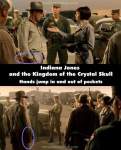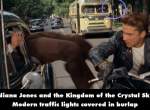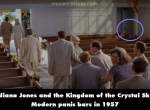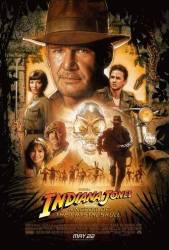
Continuity mistake: At the beginning when Indy is talking to Spalko, his hands keep alternating from being in his pockets to just resting at his sides between shots.
Factual error: In the warehouse scene, the lights and other metal objects are affected by the box's magnetic field. Yet the soldiers easily lift the box into a metal truck to load it and slide it forward. If the box's magnetic field was as strong as suggested, it would have dragged the soldiers forward as it was magnetically attracted to the truck, and it would have taken much more effort for them to slide it onto the truck bed once it was stuck there.
Visible crew/equipment: When Dr. Irina Spalko is descending the cliff, you can briefly see the harness cable that is holding her up right next to the rope on which she is climbing down.
Factual error: The 1950s kitchen scene shows a sink faucet "Dishmaster Model 87" which wasn't manufactured until 1987. The 1950's "Dishmasters" were different.
Factual error: The movie supposedly is set in 1957, yet Mutt's motorcycle is based on a 2000 or newer Harley Davidson softail, showing the modern-day controls and Twin Cam motor, instead of the panhead motor that would have been the period-correct engine for 1957. It also has a front disc brake - you can see the master cylinder on the handlebars. Again, out-of-place on a 1957 bike.
Continuity mistake: After Indiana and team fall off the disappearing stairs as they make their way into the lost city, they are walking around in the water. But when they step through the next door into the treasure room, all are completely dry.
Factual error: Indy and Mutt fly to Nazca, Peru. Nazca is only 4 hours away on bus from the capital Lima, yet the city they show on the movie is Cuzco, which is 24 hours away from Lima. Cuzco is on the east side of the country, Nazca is on the west coast right next to Lima. Also, back in 1957 only Lima had an airport, yet they show a Nazca airport that didn't exist.
Plot hole: Hiding in a fridge (or anything else) in order to be conveniently blown out of the way by an exploding nuclear device is absurd beyond belief. The fridge is just so much extra reaction mass and would be vaporised by the expanding nuclear explosion - it wouldn't be daintily picked up and thrown a few kilometers to safety. If it was, why doesn't it land in a shower of similar artifacts which have also been dislodged and thrown around? Incidentally, even if it was thrown out of the way as shown, anyone inside it would be turned into a smear of strawberry jam by the acceleration required to beat the shock and heat wave of a nuclear blast, and then liquefied by the deceleration involved in hitting the ground at that speed.
Continuity mistake: When Indiana and Mutt are in the diner, at the start of the scene there is a pretty blonde girl sitting at the counter just past the corner. A moment later, her seat and the one next to it are occupied by the two Russian guys in suits, and she is talking to a guy with glasses who was earlier by himself. Not enough time had passed for that to change.
Factual error: When Indy and Mutt are flying to Peru, a Pan American Aircraft is shown. It is an Antonov AN-2. Pan Am never flew this Russian aircraft! Also, the shot is backwards; the writing on the aircraft (airline name and registration) read backwards.

Factual error: During the motorcycle chase seen (which was filmed in New Haven, CT) one can see modern yellow traffic lights covered in burlap in a few of the scenes.
Factual error: The movie shows Mayan warriors talking Quechua in the Peruvian jungle instead of showing Inca Warriors.
Continuity mistake: When Indiana Jones is locked in the chair at the Russian camp, there is a reel-to-reel tape recorder machine running to Indy's left. When you first see it, the amount of tape on the left reel is low. Then, when Irina Spalko walks in, she goes over to it and flicks a switch. As the camera moves out, the tape on the left-hand reel is suddenly nearly equal to the one on the right.
Continuity mistake: In the tent, Indy's wrists are tied and he's facing the crystal skull. From one angle his hands are clenched fists, but from a different one they hang loose. The difference is noticable because the angles keep swapping and the hand positions are not continuous.
Continuity mistake: In the forest car chase, towards the end of Mutt's sword-fight, we see Indy driving a car behind Mutt. It cuts to Mutt picking up the skull and then back and Indy's car has disappeared. Then, as Mutt falls off the car, magically Indy appears in time to catch him.

Factual error: In the church, you can see modern brass panic bars on the doors.
Continuity mistake: When Indy and Irina are standing in the foreground analyzing Ox's drawings, look over Indy's shoulder and you will see Ox, Marion and Mutt standing up and moving forward. After the scene cuts a couple of times, a soldier asks them to stand up and move forward again.
Factual error: In the scene where they are flying to Peru from US, they fly over a "map" of a Central America region and the country of Belize is shown. That country was the British Honduras until 1973. It was then renamed to Belize.
Continuity mistake: During the beginning chase with Mutt and Indy, the bus goes from next to them in one shot to behind them in another.
Continuity mistake: When Indy and Mutt first meet in the diner scene, look out the window behind Indy. A group of leather-clad bikers are sitting and talking on their motorcycles. They vanish and reappear at least three times during the scene.






Answer: Yep, you've forgotten some details. The Knight specifically states that the immortality bestowed by the Grail is limited to those who remain within the shrine. Jones Snr left the cave, ergo, no immortality.
Tailkinker ★